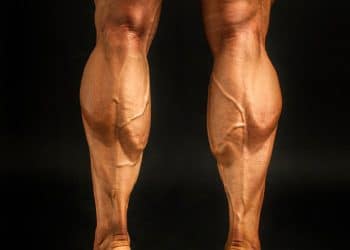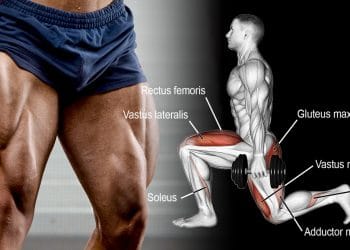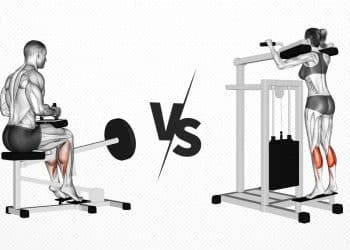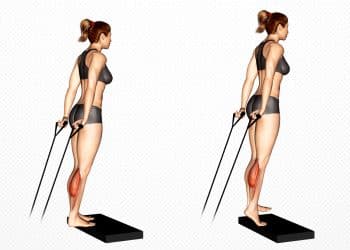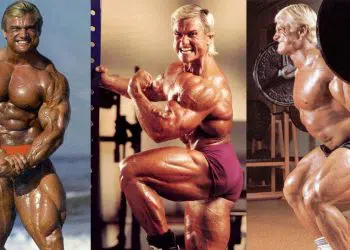Despite the convenience of machines that make working the calves essentially stress-free, there are many reasons to do the dumbbell standing calf raise.
For example, you may train at home or you may not like the gym machines. There are also times when someone’s using your favorite calf machine. So what to do? The standing dumbbell variation of course.
Learn more about this exercise including how to do it with tips, variations, and we’ve also explained how to most effectively incorporate it into your workouts.
| Exercise Reverse: Dumbbell Standing Calf Raise | |
|---|---|
| Exercise Also Called | Calf Raise |
| Primary Muscles | Gastrocnemius and soleus |
| Difficulty | Beginner |
| Function | Hypertrophy, strength |
| Mechanics | Isolation |
| Force | Push |
| Required Equipment | Dumbbells |
Muscles Worked
It’s no secret that the dumbbell standing calf raise works the calf muscles. But you should know the anatomy of the calves to understand how to maximize your training efforts.
Gastrocnemius
This gastrocnemius is the largest of all calf muscles. When you view someone performing calf raises, this is the muscle you’ll see flexing and elongating. It has a medial and lateral head and with the smaller soleus, gastrocnemius performs plantarflexion (point the town down and away from the leg) of the foot and ankle, as well as flexion of the knee.
Level Up Your Fitness: Join our 💪 strong community in Fitness Volt Newsletter. Get daily inspiration, expert-backed workouts, nutrition tips, the latest in strength sports, and the support you need to reach your goals. Subscribe for free!
Gastrocnemius is believed to possess a higher number of Type II fast-twitch muscle fibers that make us explosive during running and jumping type activities. It also crosses the knee joint and because of that standing calf raises may stimulate the gastrocnemius better than seated variations.
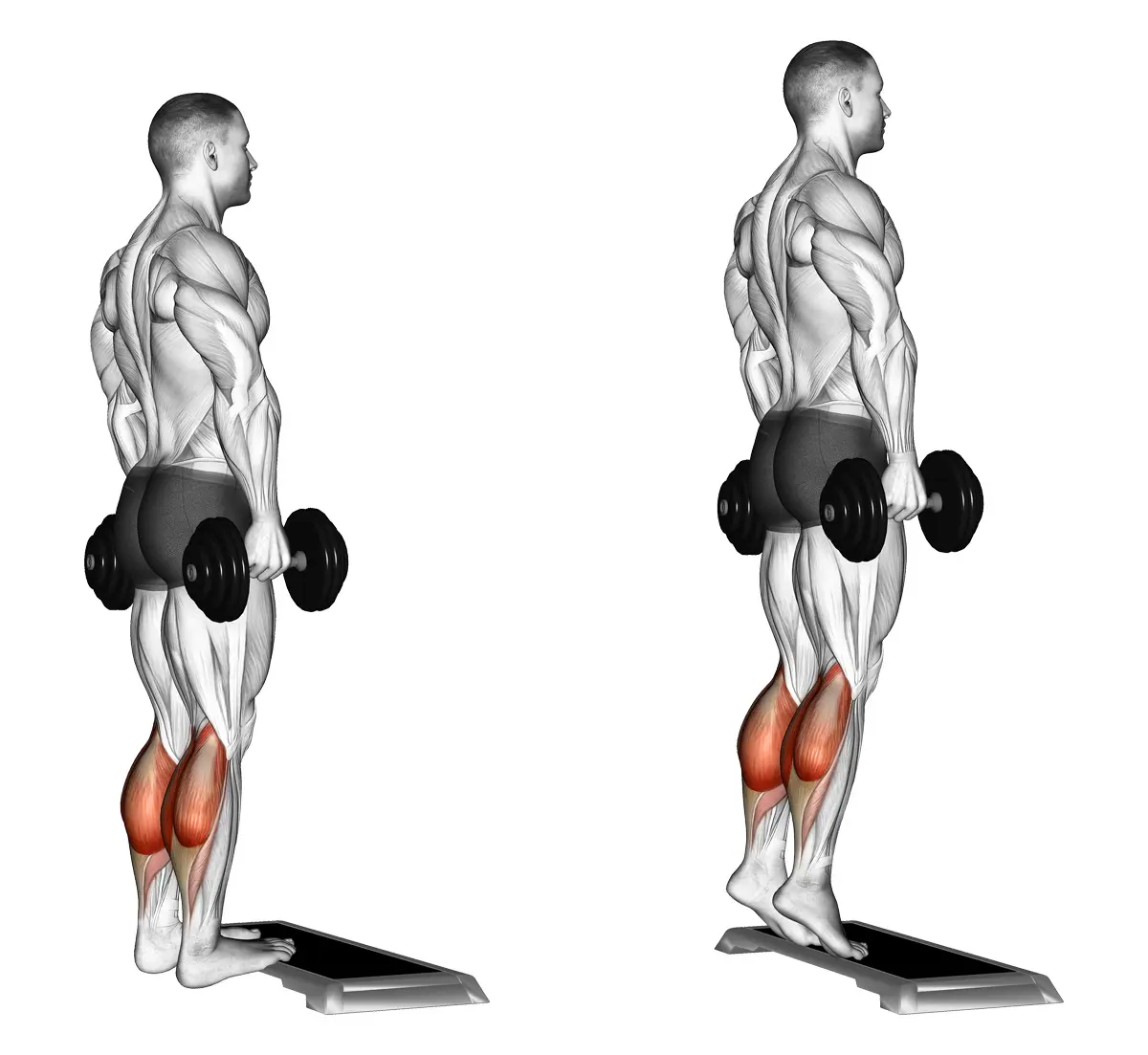
Soleus
The soleus calf muscle is smaller and deeper than the gastrocnemius and therefore not as visible. However, it does perform the same function which is to plantarflex the foot and ankle. Compared to the gastrocnemius, the soleus has a predominance of Type I slow-twitch muscle fibers and is, therefore, a better endurance calf muscle.
Seated calf raises may be better at maximizing activation of the soleus as the gastrocnemius is shortened and sort of at a mechanical disadvantage.
Learn more about how different exercises can be more effective for either calf muscle here.
How To Do The Dumbbell Standing Calf Raise
There are a few different ways to do this exercise depending on your preference and/or available equipment. Although, if you have a dumbbell and something to step up onto (e.g., spotting platform, doorstep, stairs, etc) to increase your range of motion (optional) then you’re good to go.
Here are step-by-step instructions for this exercise.
- Holding a dumbbell in one hand, place the top or ball of the same side foot onto an elevated surface/object such as one of the examples mentioned above. Keep your leg/s straight.
- The back half of your foot including your heel should be hanging off so that you can lower it down to ensure you’re using a full range of motion and get a nice stretch in the calf muscles.
- Lower your heel slowly and under control until you feel a decent stretch in the muscle/s.
- Flex your calf muscle to lift your heel and squeeze at the top for a second or two.
Repeat for the desired number of reps and do the same with the opposite leg unless working both calves at the same time.
Dumbbell standing calf raise tips
- Always make sure to do a few warm-up sets and we recommend easing into using a larger range of motion.
- Never use heavy weight for this exercise unless you’ve sufficiently warmed up. However, be careful to not overstretch the calves if you are going to use challenging poundages.
- If training both calves at the same time, you’d be better to use a weight plate or something similar that’s lower to the grounds this makes it much easier to maintain your balance and get an effective workout. Alternatively, you could keep your feet flat on the ground.
- Feel free to use any weight training tool such as a barbell, kettlebell, etc.
3 Variations/Alternatives
While the dumbbell standing calf raise is an excellent calf-building exercise, we like other ones too and you may as well. Here are a few variations/alternatives that we recommend.
[Related: The 11 Most Effective Calf Raise Exercises]
Seated free weight calf raise
If you want to hit more of the soleus muscle and don’t have a seated calf raise machine, you could sit on a bench or chair and hold a weight on your thighs near your knee and perform calf raises.
Level Up Your Fitness: Join our 💪 strong community in Fitness Volt Newsletter. Get daily inspiration, expert-backed workouts, nutrition tips, the latest in strength sports, and the support you need to reach your goals. Subscribe for free!
You can place something on the ground to lift your heel if you want to get more range of motion.
Seated calf raise machine
The seated calf raise may be more comfortable and convenient as it has pads that sit on your thighs and you won’t have to balance and weight. Plus you can really load up the machine and push yourself, use drop sets and other training methods a bit easier.
[Also read: 6 Awesome Calf Exercises You’re Probably Not Doing But Should Be]
Smith machine or gripless calf raise machine
You can use a Smith machine or any standing calf raise machine to overload the calves more than you could if using a dumbbell. This can be beneficial for building muscle and maximizing your strength.
These variations also help to maximize the activation of the gastrocnemius and are more likely to have carryover to athletic activities.
Plus, a smith machine is one of the best ways to do the donkey calf raise which is a very effective movement that we think everyone should include in their calf workouts. That is, of course, unless you have a dedicated donkey calf raise machine.
Anyhow, this exercise was commonly used by legends such as Arnold Schwarzenegger who’d have a few people sit on his back. But today, we don’t have to do that.
Using Dumbbell Standing Calf Raise in Training Routine
If possible, you should include at least one standing and one seated calf raise exercise in your workouts to maximize the activation of both the gastrocnemius and soleus.
The dumbbell standing calf raise is an excellent choice for the standing variation. Not to mention, it can easily be done at home or anywhere whether you have dumbbells or anything similar. But some people choose to do them using only their bodyweight because it challenging enough.
The calves tend to be a stubborn muscle compared to others and are highly genetic so training them more often could be to your advantage.
Sets/reps
We recommend doing at least 3 sets of a standing calf raise exercise and varying your rep ranges. The calves can respond to higher reps with moderate weight and lower reps with heavier weights.
Because of this, we recommend incorporating both. You do need to also implement progressive overload to ensure you’re challenging the calves and forcing them to grow and get stronger.
[Related article: Best Old-School Calf Workouts & Exercises]
Wrapping Up
The dumbbell standing calf raise is an exercise we’d recommend to anyone who could do them safely. You don’t need much equipment except a dumbbell and even then, you could use any type of weight if necessary.
We hope you found this exercise guide helpful and we’re confident you have the knowledge to start making big calf gains!
Interested in measuring your progress? Check out our strength standards for Seated Calf Raise, Donkey Calf Raise.



